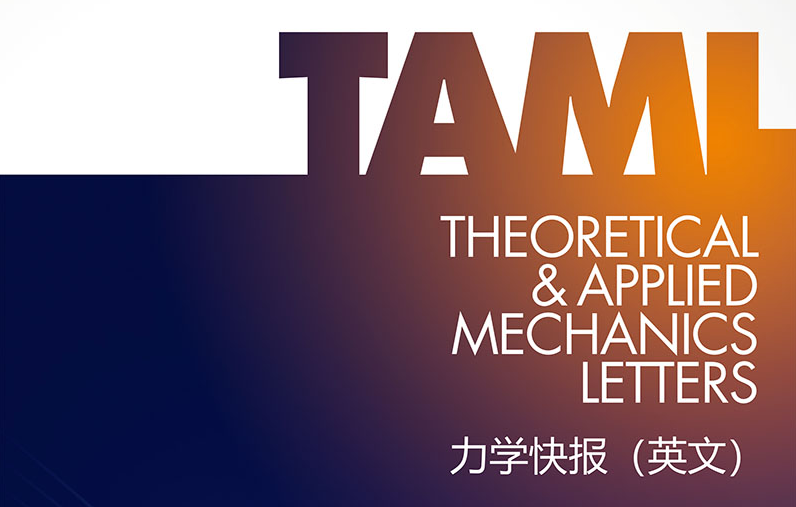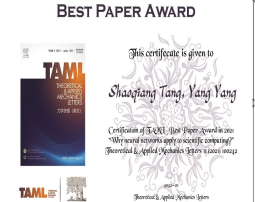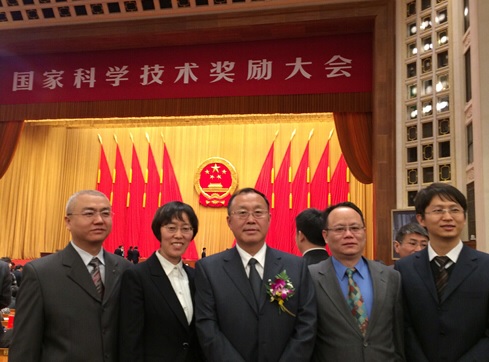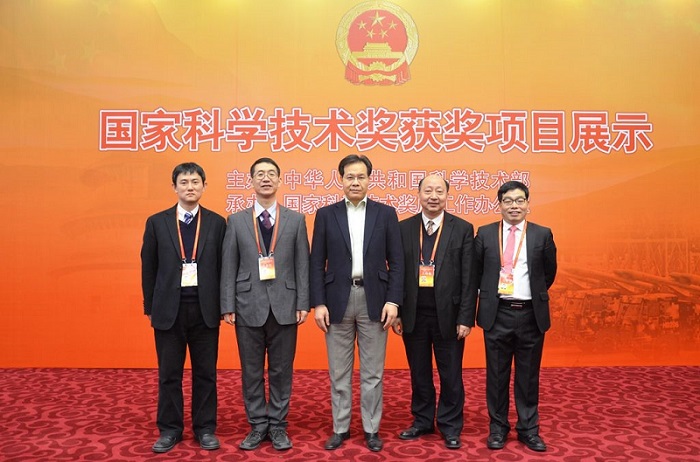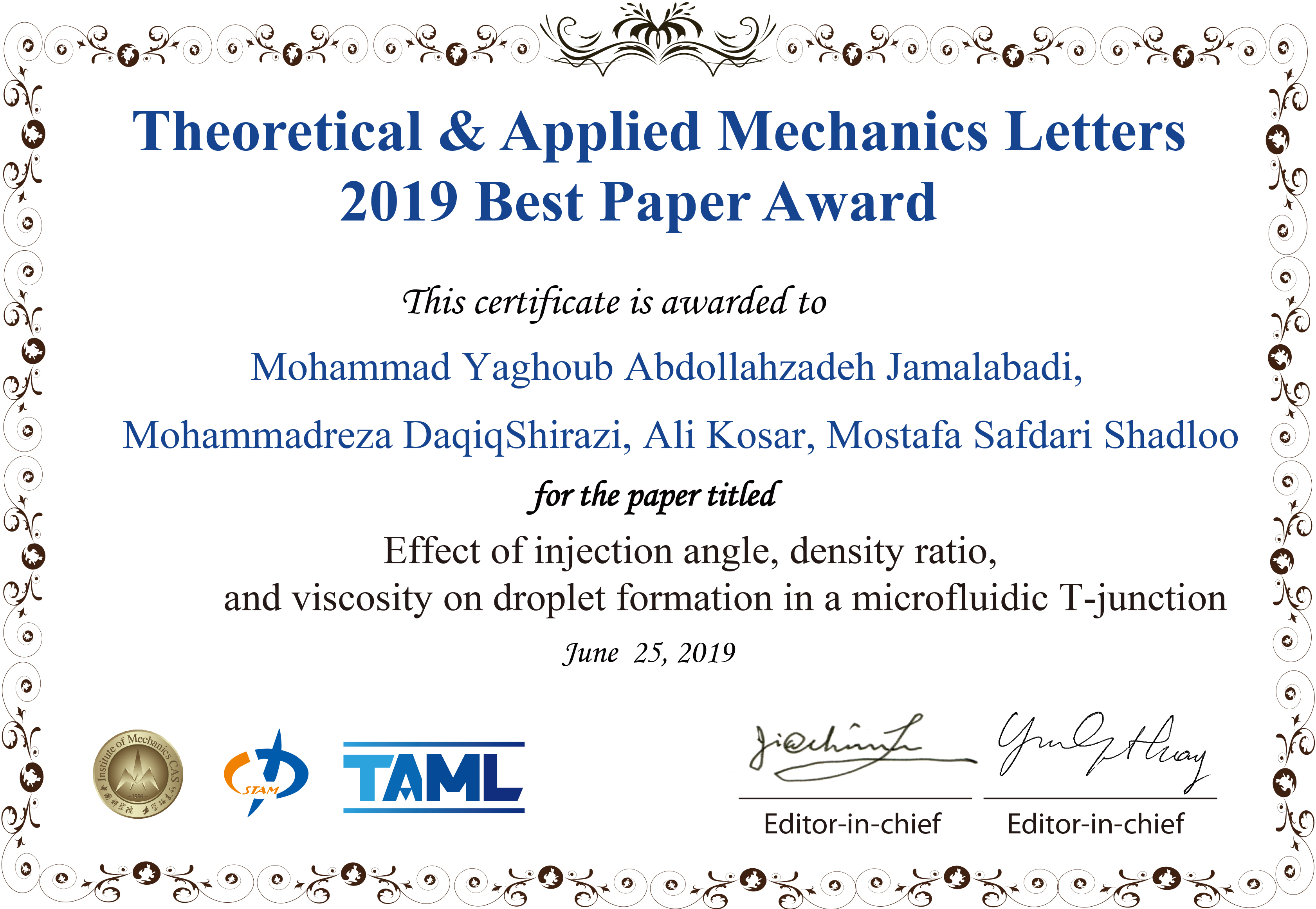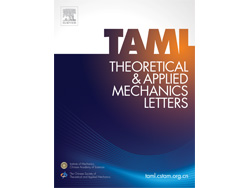Institute of Mechanics,
Chinese Academy of Sciences
2023 Vol.13(1)
Display Mode: |
Theoretical and Applied Mechanics Letters 13 (2023) 100416.
doi: 10.1016/j.taml.2022.100416
Abstract:
Machine learning has attracted much attention in various fields of mechanics. It can represent high-dimensional complex nonlinear systems and has powerful optimization algorithms. So far, machine learning has achieved much success in various mechanical simulation problems, including reconstruction and reduced-order modeling of complex mechanical systems, turbulence modeling and simulation, aerodynamic optimization design for wings, flow control, etc.
Machine learning has attracted much attention in various fields of mechanics. It can represent high-dimensional complex nonlinear systems and has powerful optimization algorithms. So far, machine learning has achieved much success in various mechanical simulation problems, including reconstruction and reduced-order modeling of complex mechanical systems, turbulence modeling and simulation, aerodynamic optimization design for wings, flow control, etc.
Theoretical and Applied Mechanics Letters 13 (2023) 100385.
doi: 10.1016/j.taml.2022.100385
Abstract:
The center manifold method has been widely used in the field of stochastic dynamics as a dimensionality reduction method. This paper studied the angular motion stability of a projectile system under random disturbances. The random bifurcation of the projectile is studied using the idea of the Routh-Hurwitz stability criterion, the center manifold reduction, and the polar coordinates transformation. Then, an approximate analytical presentation for the stationary probability density function is found from the related Fokker–Planck equation. From the results, the random dynamical system of projectile generates three different dynamical behaviors with the changes of the bifurcation parameter and the noise strength, which can be a reference for projectile design.
The center manifold method has been widely used in the field of stochastic dynamics as a dimensionality reduction method. This paper studied the angular motion stability of a projectile system under random disturbances. The random bifurcation of the projectile is studied using the idea of the Routh-Hurwitz stability criterion, the center manifold reduction, and the polar coordinates transformation. Then, an approximate analytical presentation for the stationary probability density function is found from the related Fokker–Planck equation. From the results, the random dynamical system of projectile generates three different dynamical behaviors with the changes of the bifurcation parameter and the noise strength, which can be a reference for projectile design.
Theoretical and Applied Mechanics Letters 13 (2023) 100393.
doi: 10.1016/j.taml.2022.100393
Abstract:
Nonlinearity and randomness are both the essential attributes for the real world, and the case is the same for the models of infectious diseases, for which the deterministic models can not give a complete picture of the evolution. However, although there has been a lot of work on stochastic epidemic models, most of them focus mainly on qualitative properties, which makes us somewhat ignore the original meaning of the parameter value. In this paper we extend the classic susceptible-infectious-removed (SIR) epidemic model by adding a white noise excitation and then we utilize the large deviation theory to quantitatively study the long-term coexistence exit problem with epidemic. Finally, in order to extend the meaning of parameters in the corresponding deterministic system, we tentatively introduce two new thresholds which then prove rational.
Nonlinearity and randomness are both the essential attributes for the real world, and the case is the same for the models of infectious diseases, for which the deterministic models can not give a complete picture of the evolution. However, although there has been a lot of work on stochastic epidemic models, most of them focus mainly on qualitative properties, which makes us somewhat ignore the original meaning of the parameter value. In this paper we extend the classic susceptible-infectious-removed (SIR) epidemic model by adding a white noise excitation and then we utilize the large deviation theory to quantitatively study the long-term coexistence exit problem with epidemic. Finally, in order to extend the meaning of parameters in the corresponding deterministic system, we tentatively introduce two new thresholds which then prove rational.
Theoretical and Applied Mechanics Letters 13 (2023) 100396.
doi: 10.1016/j.taml.2022.100396
Abstract:
Metal additive manufacturing (MAM) is an emerging and disruptive technology that builds three-dimensional (3D) components by adding layer-upon-layer of metallic materials. The complex cyclic thermal history and highly localized energy can produce large temperature gradients, which will, in turn, lead to compressive and tensile stress during the MAM process and eventually result in residual stress. Being an issue of great concern, residual stress, which can cause distortion, delamination, cracking, etc., is considered a key mechanical quantity that affects the manufacturing quality and service performance of MAM parts. In this review paper, the ongoing work in the field of residual stress determination and control for MAM is described with a particular emphasis on the experimental measurement/control methods and numerical models. We also provide insight on what still requires to be achieved and the research opportunities and challenges.
Metal additive manufacturing (MAM) is an emerging and disruptive technology that builds three-dimensional (3D) components by adding layer-upon-layer of metallic materials. The complex cyclic thermal history and highly localized energy can produce large temperature gradients, which will, in turn, lead to compressive and tensile stress during the MAM process and eventually result in residual stress. Being an issue of great concern, residual stress, which can cause distortion, delamination, cracking, etc., is considered a key mechanical quantity that affects the manufacturing quality and service performance of MAM parts. In this review paper, the ongoing work in the field of residual stress determination and control for MAM is described with a particular emphasis on the experimental measurement/control methods and numerical models. We also provide insight on what still requires to be achieved and the research opportunities and challenges.
Theoretical and Applied Mechanics Letters 13 (2023) 100403.
doi: 10.1016/j.taml.2022.100403
Abstract:
The snap fit is a common mechanical mechanism. We have studied the spherical snap fit carefully for its physical asymmetry, which is easy to assemble but difficult to disassemble. Because of the complexity of spherical snap fit, it is difficult to get a theoretical formula to describe its physical asymmetry. In this paper, the pushing assembly and pulling disassembly of spherical snap fit are studied by both finite element analysis and experiments. The theoretical formulaes of spherical snap fit have been obtained based on numerical simulations and theoretical results of cylindrical snap fit.
The snap fit is a common mechanical mechanism. We have studied the spherical snap fit carefully for its physical asymmetry, which is easy to assemble but difficult to disassemble. Because of the complexity of spherical snap fit, it is difficult to get a theoretical formula to describe its physical asymmetry. In this paper, the pushing assembly and pulling disassembly of spherical snap fit are studied by both finite element analysis and experiments. The theoretical formulaes of spherical snap fit have been obtained based on numerical simulations and theoretical results of cylindrical snap fit.
Theoretical and Applied Mechanics Letters 13 (2023) 100402.
doi: 10.1016/j.taml.2022.100402
Abstract:
A new algorithm is proposed to solve the problems of shape-finding of suspension bridge with spatial cables what include tedious iteration, slow convergence speed and even no convergent under some circumstances. In this paper, the stress analysis of the main cable is carried out, and the relationship between the slope change and the coordinate change is found. This paper also discussed how to find the minimum slope point of symmetrical or asymmetric main cable, and the deformation compatibility equation is established and solved to obtain the shape of main cable. The algorithm in this paper can ensure the convergence of the solution for the suspension bridge with spatial cables. The calculation accuracy is high through the demonstration of the calculation examples.
A new algorithm is proposed to solve the problems of shape-finding of suspension bridge with spatial cables what include tedious iteration, slow convergence speed and even no convergent under some circumstances. In this paper, the stress analysis of the main cable is carried out, and the relationship between the slope change and the coordinate change is found. This paper also discussed how to find the minimum slope point of symmetrical or asymmetric main cable, and the deformation compatibility equation is established and solved to obtain the shape of main cable. The algorithm in this paper can ensure the convergence of the solution for the suspension bridge with spatial cables. The calculation accuracy is high through the demonstration of the calculation examples.
Theoretical and Applied Mechanics Letters 13 (2023) 100386.
doi: 10.1016/j.taml.2022.100386
Abstract:
Two-dimensional time-resolved particle image velocimetry (TR-PIV) and stereographic particle image velocimetry (SPIV) techniques were used to investigate the effect of leading-edge tubercles on the flow over low-aspect-ratio wing models. The angle of attack is fixed at 10°, and the Reynolds number based on chord length is 5.8 × 103. It is shown that the leading-edge tubercles can effectively mitigate flow separation in the model and also reduce the contribution of wake vortex to the fluctuating energy of flow. Counter-rotating vortex pairs (CVPs) initiated from the peak of leading-edge tubercles can promote nearby momentum exchange, enhance mixing of the flow and increase the energy contained in the boundary layer, which results in resisting the larger adverse pressure gradient. Therefore, it is concluded that CVPs play an important role in mitigating the flow separation for wings with leading-edge tubercles.
Two-dimensional time-resolved particle image velocimetry (TR-PIV) and stereographic particle image velocimetry (SPIV) techniques were used to investigate the effect of leading-edge tubercles on the flow over low-aspect-ratio wing models. The angle of attack is fixed at 10°, and the Reynolds number based on chord length is 5.8 × 103. It is shown that the leading-edge tubercles can effectively mitigate flow separation in the model and also reduce the contribution of wake vortex to the fluctuating energy of flow. Counter-rotating vortex pairs (CVPs) initiated from the peak of leading-edge tubercles can promote nearby momentum exchange, enhance mixing of the flow and increase the energy contained in the boundary layer, which results in resisting the larger adverse pressure gradient. Therefore, it is concluded that CVPs play an important role in mitigating the flow separation for wings with leading-edge tubercles.
Theoretical and Applied Mechanics Letters 13 (2023) 100387.
doi: 10.1016/j.taml.2022.100387
Abstract:
A mapping function between the Reynolds-averaged Navier-Stokes mean flow variables and transition intermittency factor is constructed by fully connected artificial neural network (ANN), which replaces the governing equation of the intermittency factor in transition-predictive Spalart-Allmaras (SA)- model. By taking SA- model as the benchmark, the present ANN model is trained at two airfoils with various angles of attack, Mach numbers and Reynolds numbers, and tested with unseen airfoils in different flow states. The a posteriori tests manifest that the mean pressure coefficient, skin friction coefficient, size of laminar separation bubble, mean streamwise velocity, Reynolds shear stress and lift/drag/moment coefficient from the present two-way coupling ANN model almost coincide with those from the benchmark SA- model. Furthermore, the ANN model proves to exhibit a higher calculation efficiency and better convergence quality than traditional SA- model.
A mapping function between the Reynolds-averaged Navier-Stokes mean flow variables and transition intermittency factor is constructed by fully connected artificial neural network (ANN), which replaces the governing equation of the intermittency factor in transition-predictive Spalart-Allmaras (SA)- model. By taking SA- model as the benchmark, the present ANN model is trained at two airfoils with various angles of attack, Mach numbers and Reynolds numbers, and tested with unseen airfoils in different flow states. The a posteriori tests manifest that the mean pressure coefficient, skin friction coefficient, size of laminar separation bubble, mean streamwise velocity, Reynolds shear stress and lift/drag/moment coefficient from the present two-way coupling ANN model almost coincide with those from the benchmark SA- model. Furthermore, the ANN model proves to exhibit a higher calculation efficiency and better convergence quality than traditional SA- model.
Theoretical and Applied Mechanics Letters 13 (2023) 100399.
doi: 10.1016/j.taml.2022.100399
Abstract:
Fully connected neural networks (FCNNs) have been developed for the closure of subgrid-scale (SGS) stress and SGS heat flux in large-eddy simulations of compressible turbulent channel flow. The FCNN-based SGS model trained using data with Mach number and Reynolds number was applied to situations with different Mach numbers and Reynolds numbers. The input variables of the neural network model were the filtered velocity gradients and temperature gradients at a single spatial grid point. The a priori test showed that the FCNN model had a correlation coefficient larger than 0.91 and a relative error smaller than 0.43, with much better reconstructions of SGS unclosed terms than the dynamic Smagorinsky model (DSM). In a posteriori test, the behavior of the FCNN model was marginally better than that of the DSM in predicting the mean velocity profiles, mean temperature profiles, turbulent intensities, total Reynolds stress, total Reynolds heat flux, and mean SGS flux of kinetic energy, and outperformed the Smagorinsky model.
Fully connected neural networks (FCNNs) have been developed for the closure of subgrid-scale (SGS) stress and SGS heat flux in large-eddy simulations of compressible turbulent channel flow. The FCNN-based SGS model trained using data with Mach number and Reynolds number was applied to situations with different Mach numbers and Reynolds numbers. The input variables of the neural network model were the filtered velocity gradients and temperature gradients at a single spatial grid point. The a priori test showed that the FCNN model had a correlation coefficient larger than 0.91 and a relative error smaller than 0.43, with much better reconstructions of SGS unclosed terms than the dynamic Smagorinsky model (DSM). In a posteriori test, the behavior of the FCNN model was marginally better than that of the DSM in predicting the mean velocity profiles, mean temperature profiles, turbulent intensities, total Reynolds stress, total Reynolds heat flux, and mean SGS flux of kinetic energy, and outperformed the Smagorinsky model.
Theoretical and Applied Mechanics Letters 13 (2023) 100413.
doi: 10.1016/j.taml.2022.100413
Abstract:
The interaction between free fast-moving bodies (or particles) and the fluid surrounding them is studied, motivated by applications in different branches of industry, biomedicine, the environment and science such as flying droplets, ice growth, dust, impacts, food grains, sport, complexity and storms. New inviscid-based modelling and results on the behaviour of two interacting bodies inside a channel flow are described. This is followed by discussion of the more-bodies extension with a view to treating arrays of bodies in a rational manner. Significant dependences on initial conditions and on the comparative body masses and moments of inertia are found for the occurrence of body-body impacts as opposed to wall-body impacts and for the associated impact times.
The interaction between free fast-moving bodies (or particles) and the fluid surrounding them is studied, motivated by applications in different branches of industry, biomedicine, the environment and science such as flying droplets, ice growth, dust, impacts, food grains, sport, complexity and storms. New inviscid-based modelling and results on the behaviour of two interacting bodies inside a channel flow are described. This is followed by discussion of the more-bodies extension with a view to treating arrays of bodies in a rational manner. Significant dependences on initial conditions and on the comparative body masses and moments of inertia are found for the occurrence of body-body impacts as opposed to wall-body impacts and for the associated impact times.
Theoretical and Applied Mechanics Letters 13 (2023) 100418.
doi: 10.1016/j.taml.2022.100418
Abstract:
To study the kinematics of flow rate and ventricular dilatation, an analytical perturbation approach of hydrocephalus has been devised. This research provides a comprehensive investigation of the characteristics of cerebrospinal fluid (CSF) flow and pressure in a hydrocephalic patient. The influence of hydrocephalic CSF, flowing rotationally with realistic dynamical characteristics on pulsatile boundaries of subarachnoid space, was demonstrated using a nonlinear controlling system of CSF. An analytical perturbation method of hydrocephalus has been developed to investigate the biomechanics of fluid flow rate and the ventricular enlargement. In this paper presents a detailed analysis of CSF flow and pressure dynamics in a hydrocephalic patient. It was elaborated with a nonlinear governing model of CSF to show the influence of hydrocephalic CSF, flowing rotationally with realistic dynamical behaviors on pulsatile boundaries of subarachnoid space. In accordance with the suggested model, the elasticity factor changes depending on how much a porous layer, in this case the brain parenchyma, is stretched. It was improved to include the relaxation of internal mechanical stresses for various perturbation orders, modelling the potential plasticity of brain tissue. The initial geometry that was utilised to create the framework of CSF with pathological disease hydrocephalus and indeed the output of simulations using this model were compared to the actual progression of ventricular dimensions and shapes in patients. According to this observation, the non - linear and elastic mechanical phenomena incorporated into the current model are probably true. Further modelling of ventricular dilation at a normal pressure may benefit from the existence of a valid model whose parameters approximate genuine mechanical characteristics of the cerebral cortex.
To study the kinematics of flow rate and ventricular dilatation, an analytical perturbation approach of hydrocephalus has been devised. This research provides a comprehensive investigation of the characteristics of cerebrospinal fluid (CSF) flow and pressure in a hydrocephalic patient. The influence of hydrocephalic CSF, flowing rotationally with realistic dynamical characteristics on pulsatile boundaries of subarachnoid space, was demonstrated using a nonlinear controlling system of CSF. An analytical perturbation method of hydrocephalus has been developed to investigate the biomechanics of fluid flow rate and the ventricular enlargement. In this paper presents a detailed analysis of CSF flow and pressure dynamics in a hydrocephalic patient. It was elaborated with a nonlinear governing model of CSF to show the influence of hydrocephalic CSF, flowing rotationally with realistic dynamical behaviors on pulsatile boundaries of subarachnoid space. In accordance with the suggested model, the elasticity factor changes depending on how much a porous layer, in this case the brain parenchyma, is stretched. It was improved to include the relaxation of internal mechanical stresses for various perturbation orders, modelling the potential plasticity of brain tissue. The initial geometry that was utilised to create the framework of CSF with pathological disease hydrocephalus and indeed the output of simulations using this model were compared to the actual progression of ventricular dimensions and shapes in patients. According to this observation, the non - linear and elastic mechanical phenomena incorporated into the current model are probably true. Further modelling of ventricular dilation at a normal pressure may benefit from the existence of a valid model whose parameters approximate genuine mechanical characteristics of the cerebral cortex.
 Submit a Paper
Submit a Paper
 Subscription
Subscription
News
MORE+
Call for Papers
MORE+
- Crossing-Mechanics Driven by Big Data
- Machine learning in the fluid mechanics research of wind energy
- Mechanics of Origami/Kirigami structures and metamaterials
- New insights and perspectives on impact biomechanics for human tissues: from injury prevention, protection to protective equipment
- Environmental Mechanics for Extreme Natural Events





